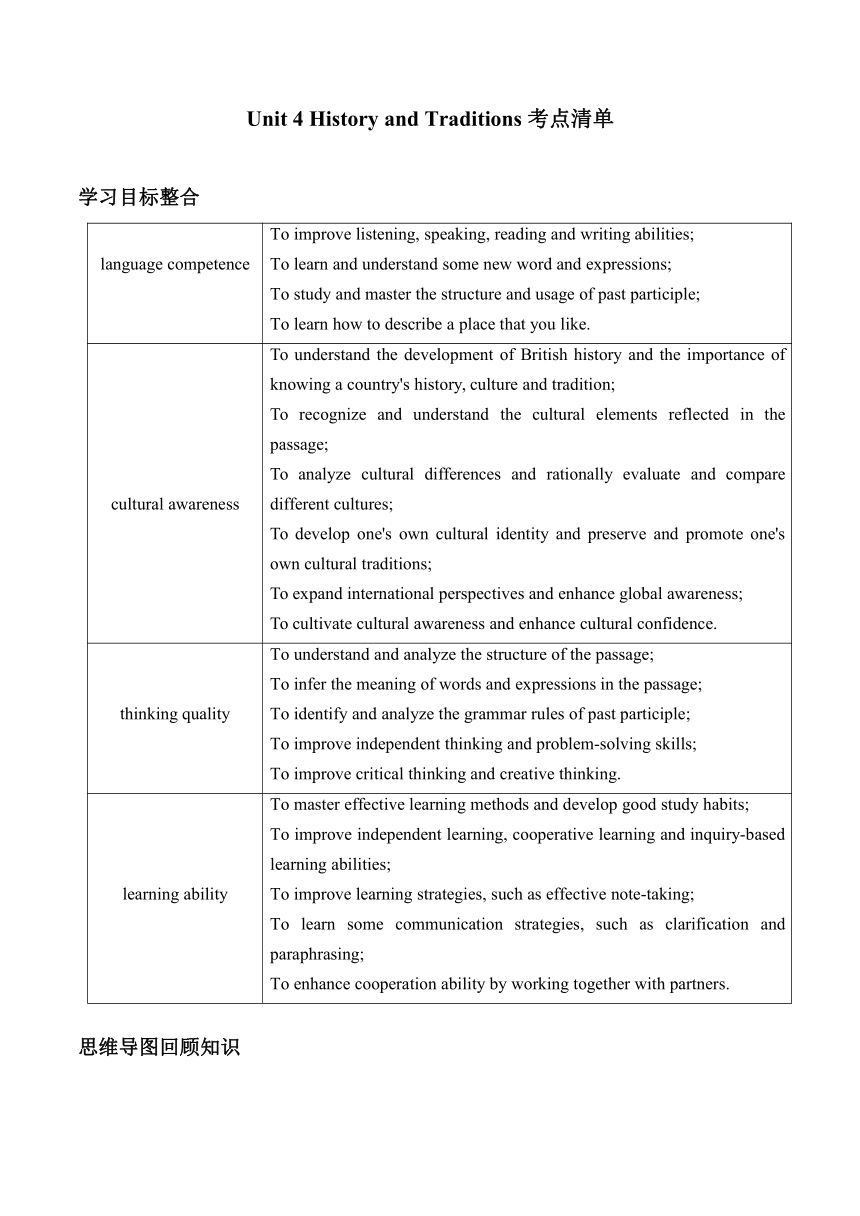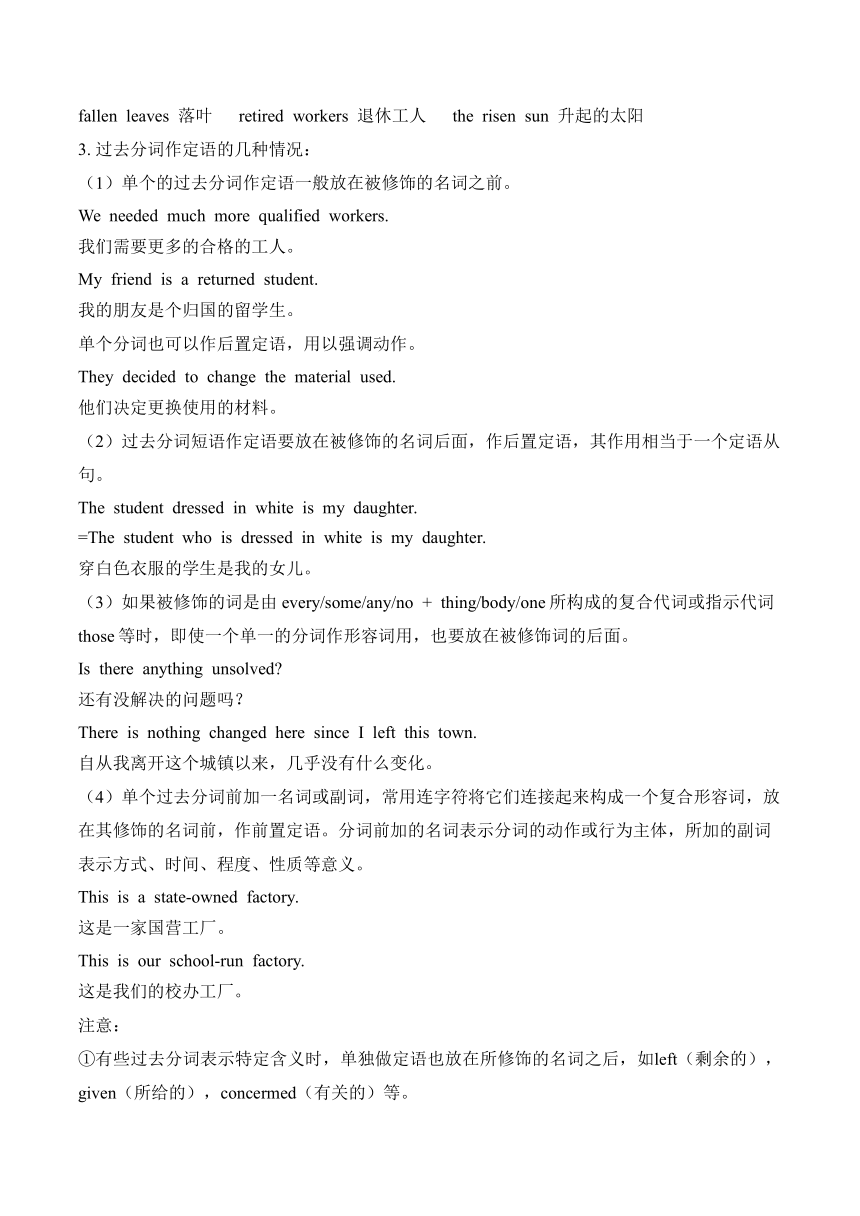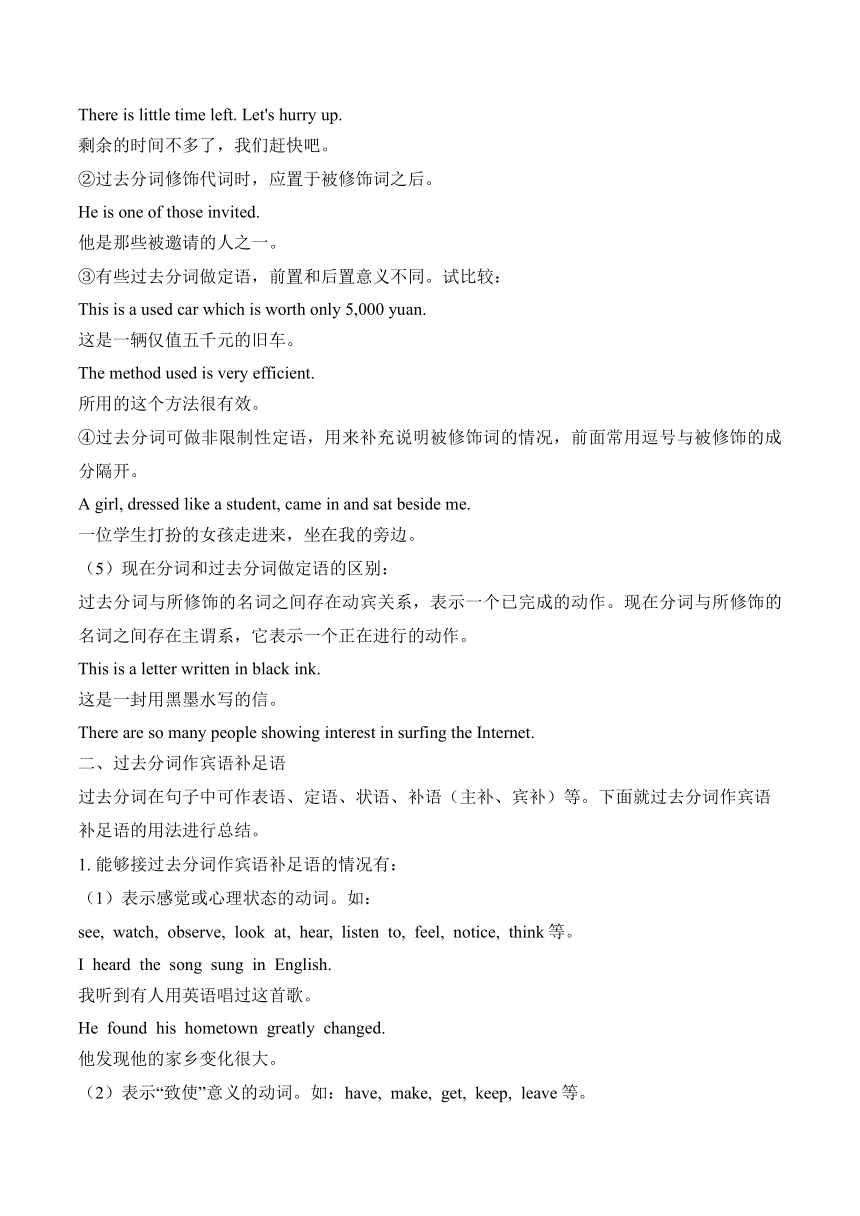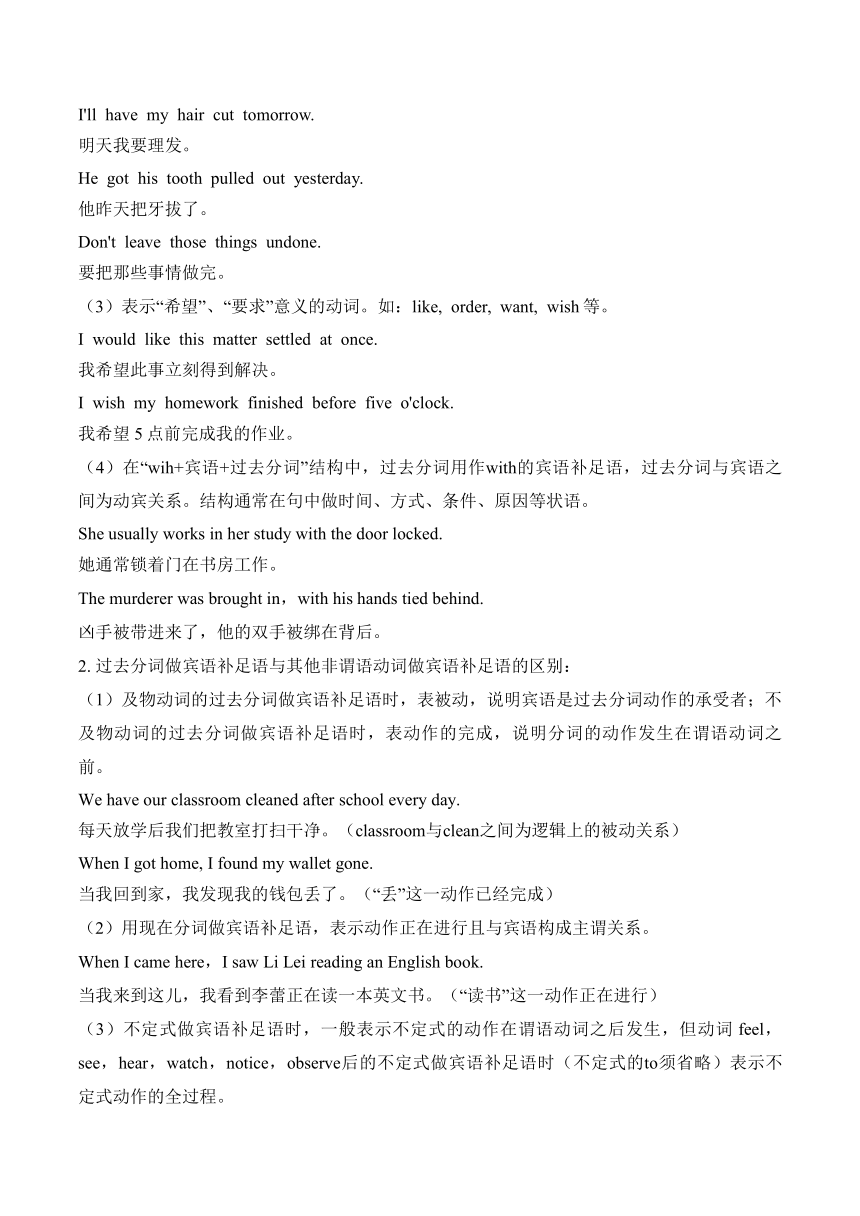人教版(2019)必修 第二册 Unit4 History and Traditions考点清单学案(含答案)
文档属性
| 名称 | 人教版(2019)必修 第二册 Unit4 History and Traditions考点清单学案(含答案) |  | |
| 格式 | docx | ||
| 文件大小 | 355.8KB | ||
| 资源类型 | 教案 | ||
| 版本资源 | 人教版(2019) | ||
| 科目 | 英语 | ||
| 更新时间 | 2024-12-24 21:12:51 | ||
图片预览





文档简介
Unit 4 History and Traditions 考点清单
学习目标整合
language competence To improve listening, speaking, reading and writing abilities; To learn and understand some new word and expressions; To study and master the structure and usage of past participle; To learn how to describe a place that you like.
cultural awareness To understand the development of British history and the importance of knowing a country's history, culture and tradition; To recognize and understand the cultural elements reflected in the passage; To analyze cultural differences and rationally evaluate and compare different cultures; To develop one's own cultural identity and preserve and promote one's own cultural traditions; To expand international perspectives and enhance global awareness; To cultivate cultural awareness and enhance cultural confidence.
thinking quality To understand and analyze the structure of the passage; To infer the meaning of words and expressions in the passage; To identify and analyze the grammar rules of past participle; To improve independent thinking and problem-solving skills; To improve critical thinking and creative thinking.
learning ability To master effective learning methods and develop good study habits; To improve independent learning, cooperative learning and inquiry-based learning abilities; To improve learning strategies, such as effective note-taking; To learn some communication strategies, such as clarification and paraphrasing; To enhance cooperation ability by working together with partners.
思维导图回顾知识
重难知识易混易错
过去分词作定语和宾语补足语
一、过去分词作定语
1. 用法
过去分词作定语,在语态上,表被动;在时间上,表示动作已经发生或完成,与它所修饰的名词有逻辑(意义)上的动宾关系。过去分词作定语时,所修饰的名词在逻辑上相当于被动句中的主语,过去分词相当于谓语。
2. 意义
(1)过去分词作定语表示动作在谓语动作之前发生,已经完成并具有被动意义。有时也不表示时间性。作定语的过去分词一般为及物动词,因为只有及物动词才有被动意义。
He is a teacher loved by his students.
他是个很受学生爱戴的老师。
(2)也有用不及物动词的过去分词作定语的情况,一般作前置定语,它不表示被动意义,只表示主动意义,强调动作完成。不能像及物动词的过去分词那样放在名词后面作定语。
fallen leaves 落叶 retired workers 退休工人 the risen sun 升起的太阳
3. 过去分词作定语的几种情况:
(1)单个的过去分词作定语一般放在被修饰的名词之前。
We needed much more qualified workers.
我们需要更多的合格的工人。
My friend is a returned student.
我的朋友是个归国的留学生。
单个分词也可以作后置定语,用以强调动作。
They decided to change the material used.
他们决定更换使用的材料。
(2)过去分词短语作定语要放在被修饰的名词后面,作后置定语,其作用相当于一个定语从句。
The student dressed in white is my daughter.
=The student who is dressed in white is my daughter.
穿白色衣服的学生是我的女儿。
(3)如果被修饰的词是由every/some/any/no + thing/body/one所构成的复合代词或指示代词those等时,即使一个单一的分词作形容词用,也要放在被修饰词的后面。
Is there anything unsolved
还有没解决的问题吗?
There is nothing changed here since I left this town.
自从我离开这个城镇以来,几乎没有什么变化。
(4)单个过去分词前加一名词或副词,常用连字符将它们连接起来构成一个复合形容词,放在其修饰的名词前,作前置定语。分词前加的名词表示分词的动作或行为主体,所加的副词表示方式、时间、程度、性质等意义。
This is a state-owned factory.
这是一家国营工厂。
This is our school-run factory.
这是我们的校办工厂。
注意:
①有些过去分词表示特定含义时,单独做定语也放在所修饰的名词之后,如left(剩余的),given(所给的),concermed(有关的)等。
There is little time left. Let's hurry up.
剩余的时间不多了,我们赶快吧。
②过去分词修饰代词时,应置于被修饰词之后。
He is one of those invited.
他是那些被邀请的人之一。
③有些过去分词做定语,前置和后置意义不同。试比较:
This is a used car which is worth only 5,000 yuan.
这是一辆仅值五千元的旧车。
The method used is very efficient.
所用的这个方法很有效。
④过去分词可做非限制性定语,用来补充说明被修饰词的情况,前面常用逗号与被修饰的成分隔开。
A girl, dressed like a student, came in and sat beside me.
一位学生打扮的女孩走进来,坐在我的旁边。
(5)现在分词和过去分词做定语的区别:
过去分词与所修饰的名词之间存在动宾关系,表示一个已完成的动作。现在分词与所修饰的名词之间存在主谓系,它表示一个正在进行的动作。
This is a letter written in black ink.
这是一封用黑墨水写的信。
There are so many people showing interest in surfing the Internet.
二、过去分词作宾语补足语
过去分词在句子中可作表语、定语、状语、补语(主补、宾补)等。下面就过去分词作宾语补足语的用法进行总结。
1. 能够接过去分词作宾语补足语的情况有:
(1)表示感觉或心理状态的动词。如:see, watch, observe, look at, hear, listen to, feel, notice, think等。
I heard the song sung in English.
我听到有人用英语唱过这首歌。
He found his hometown greatly changed.
他发现他的家乡变化很大。
(2)表示“致使”意义的动词。如:have, make, get, keep, leave等。
I'll have my hair cut tomorrow.
明天我要理发。
He got his tooth pulled out yesterday.
他昨天把牙拔了。
Don't leave those things undone.
要把那些事情做完。
(3)表示“希望”、“要求”意义的动词。如:like, order, want, wish等。
I would like this matter settled at once.
我希望此事立刻得到解决。
I wish my homework finished before five o'clock.
我希望5点前完成我的作业。
(4)在“wih+宾语+过去分词”结构中,过去分词用作with的宾语补足语,过去分词与宾语之间为动宾关系。结构通常在句中做时间、方式、条件、原因等状语。
She usually works in her study with the door locked.
她通常锁着门在书房工作。
The murderer was brought in,with his hands tied behind.
凶手被带进来了,他的双手被绑在背后。
2. 过去分词做宾语补足语与其他非谓语动词做宾语补足语的区别:
(1)及物动词的过去分词做宾语补足语时,表被动,说明宾语是过去分词动作的承受者;不及物动词的过去分词做宾语补足语时,表动作的完成,说明分词的动作发生在谓语动词之前。
We have our classroom cleaned after school every day.
每天放学后我们把教室打扫干净。(classroom与clean之间为逻辑上的被动关系)
When I got home, I found my wallet gone.
当我回到家,我发现我的钱包丢了。(“丢”这一动作已经完成)
(2)用现在分词做宾语补足语,表示动作正在进行且与宾语构成主谓关系。
When I came here,I saw Li Lei reading an English book.
当我来到这儿,我看到李蕾正在读一本英文书。(“读书”这一动作正在进行)
(3)不定式做宾语补足语时,一般表示不定式的动作在谓语动词之后发生,但动词 feel,see,hear,watch,notice,observe后的不定式做宾语补足语时(不定式的to须省略)表示不定式动作的全过程。
The teacher will have Li Lei clean the classroom today.
今天老师将让李蕾打扫教室。(Li Lei与clean之间为逻辑上的主动关系,clean 这一动作发生在have之后)
I heard Wei Fang sing this song.
我听到魏芳唱了这首歌。(“我”听见了“唱”的整个过程)
练习:
1.It is no wonder that the whole building is now in______ (ruin); it caught fire last night.
2.Michael put up a picture of this famous scientist beside the bed to keep himself _____(remind) of his own dreams.
3.A great number of immediate measures have been taken _____ (ensure) people’s lives and safety.
4.Some people are tired of the _____(crowd) city streets. They prefer to live in the countryside, where they can live a peaceful life.
5.Nowadays, more and more people like to do shopping online and have goods _____(deliver).
6.Orange trees make great gifts and you see them many times _____(decorate) with red envelopes and messages of good fortune.
7.They managed to make themselves _______(understand) by using very simple English.
8.Some people like to show their _____(generous) by hosting a big meal.
9.Most of the people _____(invite) to the party didn't turn up because of the heavy rain.
10.Most colleges now offer first-year students a course specially _____ (design) to help them succeed academically and personally.
答案:
1.答案:ruins
解析:句意为: 难怪整座大楼现在一片狼藉, 昨晚大楼起了大火。in ruins 为固定搭配,意为“毁坏; 严重受损”。故填 ruins。
2.答案:reminded
解析:考查过去分词作宾语补足语。此处为“keep+宾语+宾语补足语”结构,宾语himself和remind之间是被动关系,故用过去分词作宾语补足语。句意:迈克尔在床边贴了一张这位著名科学家的照片来提醒他他自己的梦想。
3.答案:to ensure
解析:考查动词不定式作目的状语。句意:已经立即采取了大量措施来确保人们的生命安全。结合句意可知此处应用动词不定式作目的状语。故填to ensure。
4.答案:crowded
解析:考查形容词。设空处修饰后面的名词短语city streets,作定语,应用形容词crowded。句意:一些人厌倦了拥挤的城市街道。他们更喜欢生活在乡村,在那里他们能过一种平静的生活。
5.答案:delivered
解析:考查过去分词作宾语补足语。此处为“have +宾语+宾语补足语”结构,宾语 goods与deliver之间为被动关系,故用过去分词作宾语补足语。句意:现在,越来越多的人喜欢网上购物,然后让别人送货。
6.答案:decorated
解析:考查过去分词作宾语补足语。此处为“see+宾语+宾语补足语”结构,宾语them(指代orange trees)与decorate之间为被动关系,故用过去分词作宾语补足语。句意:橘子树是很好的礼物,你会经常看到它们上面装饰着红包和祝福好运的信息。
7.答案:understood
解析:考查过去分词作宾语补足语。此处为“make+宾语+宾语补足语”结构,宾语themselves和understand之间是被动关系,故用过去分词作宾语补足语。句意:他们通过使用很简单的英语设法使自己被理解了。
8.答案:generosity
解析:考查名词。设空处作show的宾语,且由设空处前面的形容词性物主代词their可知此处应填名词generosity。句意:一些人喜欢操办一桌丰盛的宴席来展示他们的慷慨大方。
9.答案:invited
解析:考查过去分词作后置定语。此处指受邀参加聚会的大部分人,设空处作后置定语,修饰前面的people, people与invite之间为被动关系,故用过去分词作后置定语。
10.答案:designed
解析:考查非谓语动词。句意:现在,大多数大学都给大学一年级的学生提供一门课程,是为了帮助他们在学业上和个人方面取得成功专门设计的。根据句意和句子结构可知, specially designed 相当于 which/ that is specially designed,作定语修饰course,故此处用过去分词,故填designed。
核心素养对接高考
一、阅读理解
When almost everyone has a mobile phone, why are more than half of Australian homes still paying for a landline(座机)
These days you'd be hard pressed to find anyone in Australia over the age of 15 who doesn't own a mobile phone. In fact plenty of younger kids have one in their pocket. Practically everyone can make and receive calls anywhere, anytime.
Still, 55 percent of Australians have a landline phone at home and only just over a quarter (29%) rely only on their smartphones, according to a survey(调查). Of those Australians who still have a landline, a third concede that it's not really necessary and they're keeping it as a security blanket-19 percent say they never use it while a further 13 percent keep it in case of emergencies. I think my home falls into that category.
More than half of Australian homes are still choosing to stick with their home phone. Age is naturally a factor(因素)—only 58 percent of Generation Ys still use landlines now and then, compared to 84 percent of Baby Boomers who've perhaps had the same home number for 50 years. Age isn't the only factor; I'd say it's also to do with the makeup of your household.
Generation Xers with young families, like my wife and I, can still find it convenient to have a home phone rather than providing a mobile phone for every family member. That said, to be honest the only people who ever ring our home phone are our Baby Boomers parents, to the point where we play a game and guess who is calling before we pick up the phone(using Caller ID would take the fun out of it).
How attached are you to your landline How long until they go the way of gas streetlamps and morning milk deliveries
1.What does paragraph 2 mainly tell us about mobile phones
A.Their target users. B.Their wide popularity.
C.Their major functions. D.Their complex design.
2.What does the underlined word "concede" in paragraph 3 mean
A.Admit. B.Argue. C.Remember. D.Remark.
3.What can we say about Baby Boomers
A.They like smartphone games. B.They enjoy guessing callers' identity.
C.They keep using landline phones. D.They are attached to their family.
4.What can be inferred about the landline from the last paragraph
A.It remains a family necessity. B.It will fall out of use some day.
C.It may increase daily expenses. D.It is as important as the gas light.
二、七选五
To an outsider, any culture can seem confusing. And the UK's got a thing or two that raises a few eyebrows. However, understand the why and things might be less puzzling. ①_______.
In a world where 61% of nations drive on the right, Brits drive on the left. Why Most people think it goes back to Medieval, maybe even Roman times. ②_______ when you remember that right-handed people wear a sword on their left hip. Travelling on the left allowed you to keep your weapon arm toward your opponent, who would be on your right. This practice continued until the 18th century when a law was passed requiring all traffic crossing London Bridge to keep to the left.
Visitors to the UK that have just washed their hands in an old-fashioned sink might be wondering why one tap is only for hot water, the other cold. ③_______. So, why this oddity It relates to a time when hot and cold water were kept separate to prevent pollution. Drinkable cold water came from a mains supply, but hot water came from attic tanks and was not considered suitable for consumption. So they were kept apart.
Millions of people drink tea worldwide, but the odd Brits put milk in theirs. Why This mysterious practice relates to the quality of china cups used in the 18th century when tea was first imposed. For the majority of Brits, the cups available couldn't stand the heat of the boiling water and would break, so milk was added first. ④_______, And this practical tweak soon became a national habit.
⑤_______. As you can see, these odd Brits have perfectly clear reasons for left-hand driving, two-tap sinks and tea with milk. Even if they still seem strange, at least now you're in the know.
A.This makes it difficult to improve
B.There is a method to the madness
C.This unusual behavior makes sense
D.You can know the origins of the practices
E.Either can make washing very uncomfortable
F.This cooled the cup enough to resist the boiling water
G.Here are the reasons for three of Brits' more puzzling practices
三、书面表达
假如你是李华,你校的交换生Bob想加入中国传统文化学习小组,并想了解该学习小组的有关情况。请你给他写一封电子邮件,包括以下内容:
1.学习时间和地点;
2.小组情况;
3.学习内容(京剧、皮影戏等)。
注意:
1.词数80左右;
2.可以适当增加细节,以使行文连贯。
参考词汇:皮影戏shadow play
______________________________________________________________________________________________________________________________________________________________________________________________________________________________________________________________________________________________________________________________________________________________________________________________________________________________________________________________________________________________________
答案以及解析
一、阅读理解
1.答案:B
解析:主旨大意题。第二段第一句说到如今,在澳大利亚你很难发现15岁以上的人没有手机,再根据第二段中的关键信息“plenty of younger kids have one”和“everyone can make and receive calls”可知第二段主要告诉我们手机非常流行。故选B。
2.答案:A
解析:词义猜测题。下文说到他们把它当作一种安全保障,19%的人永远不会使用它,13%的人保留座机是为了预防紧急情况,所以此处是指有三分之一的人承认座机不是必需的。画线词意为“承认”,故选A。
3.答案:C
解析:推理判断题。根据第四段中的“84 percent of Baby Boomers who've perhaps had the same home number for 50 years”可知84%的婴儿潮一代可能50年来都拥有相同的家庭号码,由此推知他们保留着使用座机的习惯。故选C。
4.答案:B
解析:推理判断题。最后一段最后一句说到还有多久座机就会重蹈街道的煤气路灯和早晨送牛奶服务的覆辙呢 作者用街道的煤气路灯和早晨送牛奶服务的例子暗示座机将来会被淘汰。故选B。
二、七选五
答案:GCEFB
解析:①过渡句。设空处上文说到英国也有一两件让人惊讶的事情,但是理解原因后这些事情也许就不会那么令人困惑了;第二段至第四段分别介绍了英国靠左驾驶、有冷热两个水龙头的洗手盆以及喝茶加牛奶的习俗及其来源,所以G项“以下是英国三种更加令人费解的做法的原因”能够起到承上启下的作用。故选G。
②细节句。下文提到习惯用右手的人会把剑佩戴在臀部左侧,靠左走会让你拿武器的手臂对着在你右边的对手,有了这个缘由,C项“这个不寻常的行为(靠左驾驶)就讲得通了”显然是符合语境的。
③细节句。设空处上文提到去英国的游客会想知道为什么老式的洗手盆边有两个水龙头,一个放冷水,一个放热水。E项“任何一个水龙头都让洗手变得非常不舒服”叙述了一个冷水水龙头和一个热水水龙头给游客带来的使用感受,符合语境。
④细节句。设空处上文提到当时,大多数英国人使用的杯子无法承受开水的温度,会破裂,因此他们就先把牛奶加进去,F项“这样就降低了杯子的温度,使其足以抵挡开水(的温度)”承接上文内容,叙述了先加牛奶的原因,符合语境。
⑤细节句。设空处下一句提到正如你所看到的,对于靠左驾驶、双水龙头的洗手盆以及加奶的茶,这些奇怪的英国人有非常清晰的理由,B项“奇怪的行为有其道理”与下文在意义上表述是一致的,符合语境。
三、书面表达
答案:
Dear Bob,
I'm glad that you're interested in traditional Chinese culture. I'm writing to tell you something about the study group for traditional Chinese culture.
The group provides opportunities to learn traditional Chinese culture, especially for exchange students. The group members have lessons in the school hall every afternoon from Monday to Thursday. Forty students have joined us, ten of whom are foreign exchange students. We learn traditional Chinese art such as Beijing Opera and the shadow play under the guidance of professional teachers.
I believe you'll like it!
Yours,
Li Hua
学习目标整合
language competence To improve listening, speaking, reading and writing abilities; To learn and understand some new word and expressions; To study and master the structure and usage of past participle; To learn how to describe a place that you like.
cultural awareness To understand the development of British history and the importance of knowing a country's history, culture and tradition; To recognize and understand the cultural elements reflected in the passage; To analyze cultural differences and rationally evaluate and compare different cultures; To develop one's own cultural identity and preserve and promote one's own cultural traditions; To expand international perspectives and enhance global awareness; To cultivate cultural awareness and enhance cultural confidence.
thinking quality To understand and analyze the structure of the passage; To infer the meaning of words and expressions in the passage; To identify and analyze the grammar rules of past participle; To improve independent thinking and problem-solving skills; To improve critical thinking and creative thinking.
learning ability To master effective learning methods and develop good study habits; To improve independent learning, cooperative learning and inquiry-based learning abilities; To improve learning strategies, such as effective note-taking; To learn some communication strategies, such as clarification and paraphrasing; To enhance cooperation ability by working together with partners.
思维导图回顾知识
重难知识易混易错
过去分词作定语和宾语补足语
一、过去分词作定语
1. 用法
过去分词作定语,在语态上,表被动;在时间上,表示动作已经发生或完成,与它所修饰的名词有逻辑(意义)上的动宾关系。过去分词作定语时,所修饰的名词在逻辑上相当于被动句中的主语,过去分词相当于谓语。
2. 意义
(1)过去分词作定语表示动作在谓语动作之前发生,已经完成并具有被动意义。有时也不表示时间性。作定语的过去分词一般为及物动词,因为只有及物动词才有被动意义。
He is a teacher loved by his students.
他是个很受学生爱戴的老师。
(2)也有用不及物动词的过去分词作定语的情况,一般作前置定语,它不表示被动意义,只表示主动意义,强调动作完成。不能像及物动词的过去分词那样放在名词后面作定语。
fallen leaves 落叶 retired workers 退休工人 the risen sun 升起的太阳
3. 过去分词作定语的几种情况:
(1)单个的过去分词作定语一般放在被修饰的名词之前。
We needed much more qualified workers.
我们需要更多的合格的工人。
My friend is a returned student.
我的朋友是个归国的留学生。
单个分词也可以作后置定语,用以强调动作。
They decided to change the material used.
他们决定更换使用的材料。
(2)过去分词短语作定语要放在被修饰的名词后面,作后置定语,其作用相当于一个定语从句。
The student dressed in white is my daughter.
=The student who is dressed in white is my daughter.
穿白色衣服的学生是我的女儿。
(3)如果被修饰的词是由every/some/any/no + thing/body/one所构成的复合代词或指示代词those等时,即使一个单一的分词作形容词用,也要放在被修饰词的后面。
Is there anything unsolved
还有没解决的问题吗?
There is nothing changed here since I left this town.
自从我离开这个城镇以来,几乎没有什么变化。
(4)单个过去分词前加一名词或副词,常用连字符将它们连接起来构成一个复合形容词,放在其修饰的名词前,作前置定语。分词前加的名词表示分词的动作或行为主体,所加的副词表示方式、时间、程度、性质等意义。
This is a state-owned factory.
这是一家国营工厂。
This is our school-run factory.
这是我们的校办工厂。
注意:
①有些过去分词表示特定含义时,单独做定语也放在所修饰的名词之后,如left(剩余的),given(所给的),concermed(有关的)等。
There is little time left. Let's hurry up.
剩余的时间不多了,我们赶快吧。
②过去分词修饰代词时,应置于被修饰词之后。
He is one of those invited.
他是那些被邀请的人之一。
③有些过去分词做定语,前置和后置意义不同。试比较:
This is a used car which is worth only 5,000 yuan.
这是一辆仅值五千元的旧车。
The method used is very efficient.
所用的这个方法很有效。
④过去分词可做非限制性定语,用来补充说明被修饰词的情况,前面常用逗号与被修饰的成分隔开。
A girl, dressed like a student, came in and sat beside me.
一位学生打扮的女孩走进来,坐在我的旁边。
(5)现在分词和过去分词做定语的区别:
过去分词与所修饰的名词之间存在动宾关系,表示一个已完成的动作。现在分词与所修饰的名词之间存在主谓系,它表示一个正在进行的动作。
This is a letter written in black ink.
这是一封用黑墨水写的信。
There are so many people showing interest in surfing the Internet.
二、过去分词作宾语补足语
过去分词在句子中可作表语、定语、状语、补语(主补、宾补)等。下面就过去分词作宾语补足语的用法进行总结。
1. 能够接过去分词作宾语补足语的情况有:
(1)表示感觉或心理状态的动词。如:see, watch, observe, look at, hear, listen to, feel, notice, think等。
I heard the song sung in English.
我听到有人用英语唱过这首歌。
He found his hometown greatly changed.
他发现他的家乡变化很大。
(2)表示“致使”意义的动词。如:have, make, get, keep, leave等。
I'll have my hair cut tomorrow.
明天我要理发。
He got his tooth pulled out yesterday.
他昨天把牙拔了。
Don't leave those things undone.
要把那些事情做完。
(3)表示“希望”、“要求”意义的动词。如:like, order, want, wish等。
I would like this matter settled at once.
我希望此事立刻得到解决。
I wish my homework finished before five o'clock.
我希望5点前完成我的作业。
(4)在“wih+宾语+过去分词”结构中,过去分词用作with的宾语补足语,过去分词与宾语之间为动宾关系。结构通常在句中做时间、方式、条件、原因等状语。
She usually works in her study with the door locked.
她通常锁着门在书房工作。
The murderer was brought in,with his hands tied behind.
凶手被带进来了,他的双手被绑在背后。
2. 过去分词做宾语补足语与其他非谓语动词做宾语补足语的区别:
(1)及物动词的过去分词做宾语补足语时,表被动,说明宾语是过去分词动作的承受者;不及物动词的过去分词做宾语补足语时,表动作的完成,说明分词的动作发生在谓语动词之前。
We have our classroom cleaned after school every day.
每天放学后我们把教室打扫干净。(classroom与clean之间为逻辑上的被动关系)
When I got home, I found my wallet gone.
当我回到家,我发现我的钱包丢了。(“丢”这一动作已经完成)
(2)用现在分词做宾语补足语,表示动作正在进行且与宾语构成主谓关系。
When I came here,I saw Li Lei reading an English book.
当我来到这儿,我看到李蕾正在读一本英文书。(“读书”这一动作正在进行)
(3)不定式做宾语补足语时,一般表示不定式的动作在谓语动词之后发生,但动词 feel,see,hear,watch,notice,observe后的不定式做宾语补足语时(不定式的to须省略)表示不定式动作的全过程。
The teacher will have Li Lei clean the classroom today.
今天老师将让李蕾打扫教室。(Li Lei与clean之间为逻辑上的主动关系,clean 这一动作发生在have之后)
I heard Wei Fang sing this song.
我听到魏芳唱了这首歌。(“我”听见了“唱”的整个过程)
练习:
1.It is no wonder that the whole building is now in______ (ruin); it caught fire last night.
2.Michael put up a picture of this famous scientist beside the bed to keep himself _____(remind) of his own dreams.
3.A great number of immediate measures have been taken _____ (ensure) people’s lives and safety.
4.Some people are tired of the _____(crowd) city streets. They prefer to live in the countryside, where they can live a peaceful life.
5.Nowadays, more and more people like to do shopping online and have goods _____(deliver).
6.Orange trees make great gifts and you see them many times _____(decorate) with red envelopes and messages of good fortune.
7.They managed to make themselves _______(understand) by using very simple English.
8.Some people like to show their _____(generous) by hosting a big meal.
9.Most of the people _____(invite) to the party didn't turn up because of the heavy rain.
10.Most colleges now offer first-year students a course specially _____ (design) to help them succeed academically and personally.
答案:
1.答案:ruins
解析:句意为: 难怪整座大楼现在一片狼藉, 昨晚大楼起了大火。in ruins 为固定搭配,意为“毁坏; 严重受损”。故填 ruins。
2.答案:reminded
解析:考查过去分词作宾语补足语。此处为“keep+宾语+宾语补足语”结构,宾语himself和remind之间是被动关系,故用过去分词作宾语补足语。句意:迈克尔在床边贴了一张这位著名科学家的照片来提醒他他自己的梦想。
3.答案:to ensure
解析:考查动词不定式作目的状语。句意:已经立即采取了大量措施来确保人们的生命安全。结合句意可知此处应用动词不定式作目的状语。故填to ensure。
4.答案:crowded
解析:考查形容词。设空处修饰后面的名词短语city streets,作定语,应用形容词crowded。句意:一些人厌倦了拥挤的城市街道。他们更喜欢生活在乡村,在那里他们能过一种平静的生活。
5.答案:delivered
解析:考查过去分词作宾语补足语。此处为“have +宾语+宾语补足语”结构,宾语 goods与deliver之间为被动关系,故用过去分词作宾语补足语。句意:现在,越来越多的人喜欢网上购物,然后让别人送货。
6.答案:decorated
解析:考查过去分词作宾语补足语。此处为“see+宾语+宾语补足语”结构,宾语them(指代orange trees)与decorate之间为被动关系,故用过去分词作宾语补足语。句意:橘子树是很好的礼物,你会经常看到它们上面装饰着红包和祝福好运的信息。
7.答案:understood
解析:考查过去分词作宾语补足语。此处为“make+宾语+宾语补足语”结构,宾语themselves和understand之间是被动关系,故用过去分词作宾语补足语。句意:他们通过使用很简单的英语设法使自己被理解了。
8.答案:generosity
解析:考查名词。设空处作show的宾语,且由设空处前面的形容词性物主代词their可知此处应填名词generosity。句意:一些人喜欢操办一桌丰盛的宴席来展示他们的慷慨大方。
9.答案:invited
解析:考查过去分词作后置定语。此处指受邀参加聚会的大部分人,设空处作后置定语,修饰前面的people, people与invite之间为被动关系,故用过去分词作后置定语。
10.答案:designed
解析:考查非谓语动词。句意:现在,大多数大学都给大学一年级的学生提供一门课程,是为了帮助他们在学业上和个人方面取得成功专门设计的。根据句意和句子结构可知, specially designed 相当于 which/ that is specially designed,作定语修饰course,故此处用过去分词,故填designed。
核心素养对接高考
一、阅读理解
When almost everyone has a mobile phone, why are more than half of Australian homes still paying for a landline(座机)
These days you'd be hard pressed to find anyone in Australia over the age of 15 who doesn't own a mobile phone. In fact plenty of younger kids have one in their pocket. Practically everyone can make and receive calls anywhere, anytime.
Still, 55 percent of Australians have a landline phone at home and only just over a quarter (29%) rely only on their smartphones, according to a survey(调查). Of those Australians who still have a landline, a third concede that it's not really necessary and they're keeping it as a security blanket-19 percent say they never use it while a further 13 percent keep it in case of emergencies. I think my home falls into that category.
More than half of Australian homes are still choosing to stick with their home phone. Age is naturally a factor(因素)—only 58 percent of Generation Ys still use landlines now and then, compared to 84 percent of Baby Boomers who've perhaps had the same home number for 50 years. Age isn't the only factor; I'd say it's also to do with the makeup of your household.
Generation Xers with young families, like my wife and I, can still find it convenient to have a home phone rather than providing a mobile phone for every family member. That said, to be honest the only people who ever ring our home phone are our Baby Boomers parents, to the point where we play a game and guess who is calling before we pick up the phone(using Caller ID would take the fun out of it).
How attached are you to your landline How long until they go the way of gas streetlamps and morning milk deliveries
1.What does paragraph 2 mainly tell us about mobile phones
A.Their target users. B.Their wide popularity.
C.Their major functions. D.Their complex design.
2.What does the underlined word "concede" in paragraph 3 mean
A.Admit. B.Argue. C.Remember. D.Remark.
3.What can we say about Baby Boomers
A.They like smartphone games. B.They enjoy guessing callers' identity.
C.They keep using landline phones. D.They are attached to their family.
4.What can be inferred about the landline from the last paragraph
A.It remains a family necessity. B.It will fall out of use some day.
C.It may increase daily expenses. D.It is as important as the gas light.
二、七选五
To an outsider, any culture can seem confusing. And the UK's got a thing or two that raises a few eyebrows. However, understand the why and things might be less puzzling. ①_______.
In a world where 61% of nations drive on the right, Brits drive on the left. Why Most people think it goes back to Medieval, maybe even Roman times. ②_______ when you remember that right-handed people wear a sword on their left hip. Travelling on the left allowed you to keep your weapon arm toward your opponent, who would be on your right. This practice continued until the 18th century when a law was passed requiring all traffic crossing London Bridge to keep to the left.
Visitors to the UK that have just washed their hands in an old-fashioned sink might be wondering why one tap is only for hot water, the other cold. ③_______. So, why this oddity It relates to a time when hot and cold water were kept separate to prevent pollution. Drinkable cold water came from a mains supply, but hot water came from attic tanks and was not considered suitable for consumption. So they were kept apart.
Millions of people drink tea worldwide, but the odd Brits put milk in theirs. Why This mysterious practice relates to the quality of china cups used in the 18th century when tea was first imposed. For the majority of Brits, the cups available couldn't stand the heat of the boiling water and would break, so milk was added first. ④_______, And this practical tweak soon became a national habit.
⑤_______. As you can see, these odd Brits have perfectly clear reasons for left-hand driving, two-tap sinks and tea with milk. Even if they still seem strange, at least now you're in the know.
A.This makes it difficult to improve
B.There is a method to the madness
C.This unusual behavior makes sense
D.You can know the origins of the practices
E.Either can make washing very uncomfortable
F.This cooled the cup enough to resist the boiling water
G.Here are the reasons for three of Brits' more puzzling practices
三、书面表达
假如你是李华,你校的交换生Bob想加入中国传统文化学习小组,并想了解该学习小组的有关情况。请你给他写一封电子邮件,包括以下内容:
1.学习时间和地点;
2.小组情况;
3.学习内容(京剧、皮影戏等)。
注意:
1.词数80左右;
2.可以适当增加细节,以使行文连贯。
参考词汇:皮影戏shadow play
______________________________________________________________________________________________________________________________________________________________________________________________________________________________________________________________________________________________________________________________________________________________________________________________________________________________________________________________________________________________________
答案以及解析
一、阅读理解
1.答案:B
解析:主旨大意题。第二段第一句说到如今,在澳大利亚你很难发现15岁以上的人没有手机,再根据第二段中的关键信息“plenty of younger kids have one”和“everyone can make and receive calls”可知第二段主要告诉我们手机非常流行。故选B。
2.答案:A
解析:词义猜测题。下文说到他们把它当作一种安全保障,19%的人永远不会使用它,13%的人保留座机是为了预防紧急情况,所以此处是指有三分之一的人承认座机不是必需的。画线词意为“承认”,故选A。
3.答案:C
解析:推理判断题。根据第四段中的“84 percent of Baby Boomers who've perhaps had the same home number for 50 years”可知84%的婴儿潮一代可能50年来都拥有相同的家庭号码,由此推知他们保留着使用座机的习惯。故选C。
4.答案:B
解析:推理判断题。最后一段最后一句说到还有多久座机就会重蹈街道的煤气路灯和早晨送牛奶服务的覆辙呢 作者用街道的煤气路灯和早晨送牛奶服务的例子暗示座机将来会被淘汰。故选B。
二、七选五
答案:GCEFB
解析:①过渡句。设空处上文说到英国也有一两件让人惊讶的事情,但是理解原因后这些事情也许就不会那么令人困惑了;第二段至第四段分别介绍了英国靠左驾驶、有冷热两个水龙头的洗手盆以及喝茶加牛奶的习俗及其来源,所以G项“以下是英国三种更加令人费解的做法的原因”能够起到承上启下的作用。故选G。
②细节句。下文提到习惯用右手的人会把剑佩戴在臀部左侧,靠左走会让你拿武器的手臂对着在你右边的对手,有了这个缘由,C项“这个不寻常的行为(靠左驾驶)就讲得通了”显然是符合语境的。
③细节句。设空处上文提到去英国的游客会想知道为什么老式的洗手盆边有两个水龙头,一个放冷水,一个放热水。E项“任何一个水龙头都让洗手变得非常不舒服”叙述了一个冷水水龙头和一个热水水龙头给游客带来的使用感受,符合语境。
④细节句。设空处上文提到当时,大多数英国人使用的杯子无法承受开水的温度,会破裂,因此他们就先把牛奶加进去,F项“这样就降低了杯子的温度,使其足以抵挡开水(的温度)”承接上文内容,叙述了先加牛奶的原因,符合语境。
⑤细节句。设空处下一句提到正如你所看到的,对于靠左驾驶、双水龙头的洗手盆以及加奶的茶,这些奇怪的英国人有非常清晰的理由,B项“奇怪的行为有其道理”与下文在意义上表述是一致的,符合语境。
三、书面表达
答案:
Dear Bob,
I'm glad that you're interested in traditional Chinese culture. I'm writing to tell you something about the study group for traditional Chinese culture.
The group provides opportunities to learn traditional Chinese culture, especially for exchange students. The group members have lessons in the school hall every afternoon from Monday to Thursday. Forty students have joined us, ten of whom are foreign exchange students. We learn traditional Chinese art such as Beijing Opera and the shadow play under the guidance of professional teachers.
I believe you'll like it!
Yours,
Li Hua
